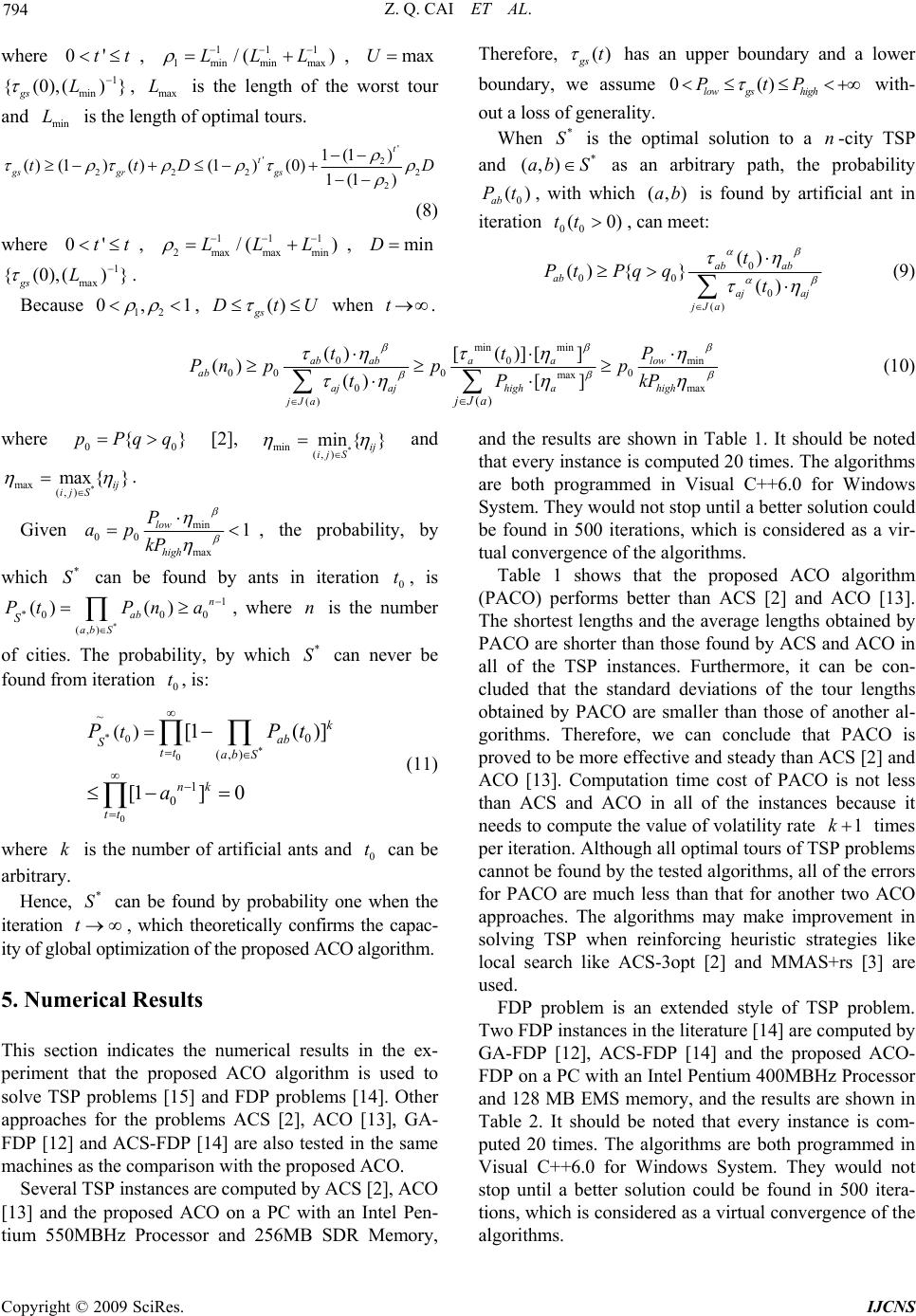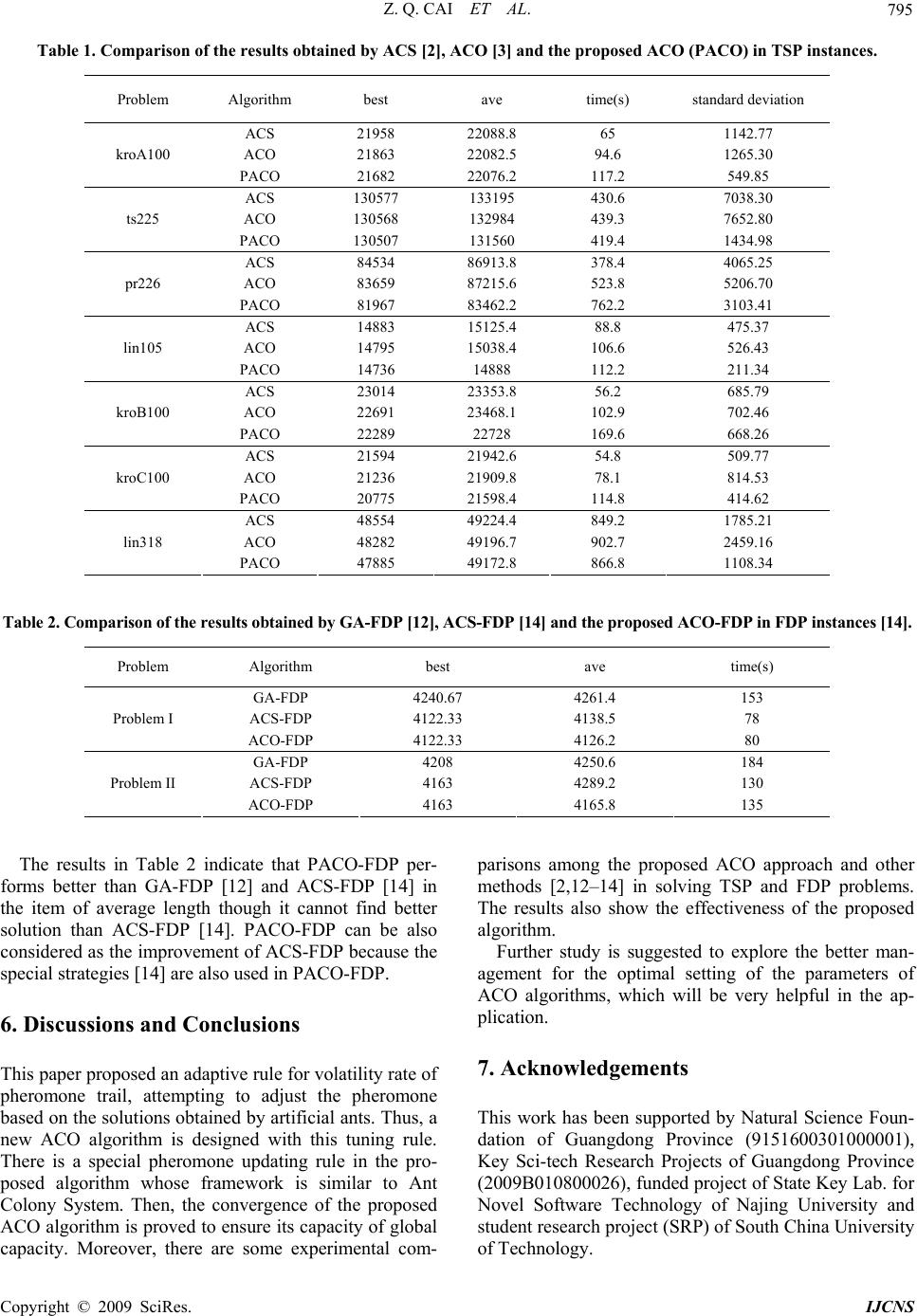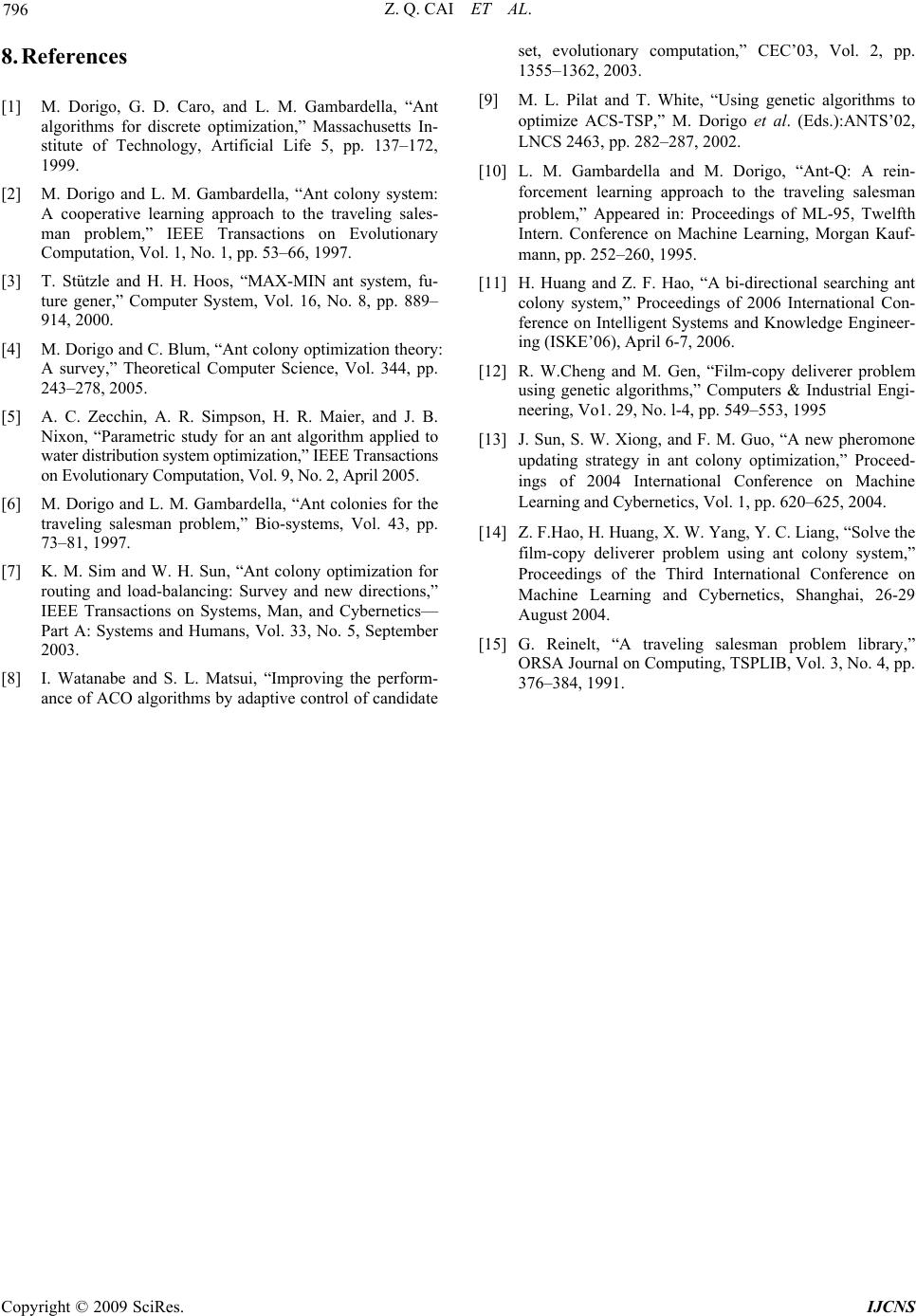Paper Menu >>
Journal Menu >>
 Int. J. Communications, Network and System Sciences, 2009, 2, 792-796 doi:10.4236/ijcns.2009.28092 blished Online November 2009 (http://www.SciRP.org/journal/ijcns/). Copyright © 2009 SciRes. IJCNS Pu Ant Colony Optimization Based on Adaptive Volatility Rate of Pheromone Trail Zhaoquan CAI1, Han HUANG2,3, Yong QIN4, Xianheng MA2 1Educational Technology Center, Huizhou University, Huizhou, China 2School of Software Engineering, South China University of Technology, Guangzhou, China 3State Key Lab for Novel Software Technology, Nanjing University, Nanjing, China 4Center of Information and Network, Maoming University, Maoming, China Email: {gdzqcai, bssthh}@163.com Received May 25, 2009; revised July 15, 2009; accepted August 13, 2009 Abstract Ant colony optimization (ACO) has been proved to be one of the best performing algorithms for NP-hard problems as TSP. The volatility rate of pheromone trail is one of the main parameters in ACO algorithms. It is usually set experimentally in the literatures for the application of ACO. The present paper first proposes an adaptive strategy for the volatility rate of pheromone trail according to the quality of the solutions found by artificial ants. Second, the strategy is combined with the setting of other parameters to form a new ACO method. Then, the proposed algorithm can be proved to converge to the global optimal solution. Finally, the experimental results of computing traveling salesman problems and film-copy deliverer problems also indi- cate that the proposed ACO approach is more effective than other ant methods and non-ant methods. Keywords: Ant Colony Optimization (ACO), Adaptive Volatility Rate, Pheromone Trail 1. Introduction ACO was first proposed by M. Dorigo and his colleagues as a multi-agent approach to deal with difficult combi- natorial optimization problems such as TSP [1]. Since then, a number of applications to the NP-hard problems have shown the effectiveness of ACO [1]. Up till now, Ant Colony System (ACS) [2] and MAX-MIN Ant Sys- tem (MMAS) [3] are so successful and classical that their strategies such as pheromone global-local update and Maximum-Minimum of pheromone are widely used in recent research [1]. The main parameters of ACO may conclude: , k , and , where is the number of artificial ants used for solution construction, k is the parameter for volatility of pheromone trail and , determines the relative importance of pheromone value and heuristic information [2,4,5]. All of the parameters are usually set with experimental methods in the application of ACO [5–7]. For the adaptive parameter setting, M. Dorigo and L.M. Gambardella presented a formula for the optimal number of ants based on the value of k and in 0 q ant colony system. I. Watanabe and S. Matsui proposed an adaptive control mechanism of the parameter candi- date sets based on the pheromone concentrations [8]. M. L., Pilat, and T. White put forward the ACSGA-TSP algorithm [9] with an adaptive evolutionary parame- ters , , and gave the experimental values of these parameters for some TSP problems. For the pa- rameters 0 q and , which regulate the relative impor- tance of pheromone trail and closeness [10], H. Huang proposed a dynamic strategy for a bi-directional search- ing ant colony system [11]. However, other parameters should be set experimentally. This paper presents a trial work of setting the parame- ters of ACO adaptively. First, a tuning rule for is designed based on the quality of the solution constructed by artificial ants. Then, we introduce the adaptive to form a new ACO algorithm, which is tested to compute several benchmark instances of traveling sales-man problem and film-copy deliverer problem. Finally, the experimental result indicates that the new ACS with adaptive performs better than GA [12], ACO [13] and ACS [2,14]. Furthermore, the convergence of the proposed ACO algorithm is proved.  Z. Q. CAI ET AL. 793 2. Adaptive Volatility Rate of Pheromone Trail The framework of ACO [1–2] is inspired by the ants’ foraging behavior in selecting the shortest path between the nest and the food. Each ant builds a tour (i.e. a feasi- ble solution to the TSP) by repeatedly applying a sto- chastic greedy rule (the state transition rule) as Equation (1) shows. () (,) (,) [()][] () [()][] () 0 m k m gs rJ g gt gs gs gt gr gr tifsJ g t Pt otherwise (1) where m g s P is the probability with which the ant chooses to move from city m g to city in iteration , st is the pheromone, 1/ d is the reciprocal of dis- tance g s d, and ( m) J g is the set of cities not having been visited yet when ant is at city m g . After constructing its tour, an artificial ant also modi- fies the amount of pheromone on the visited edges by applying the pheromone updating rule. The rule is de- signed so that it tends to give more pheromone to the edges which should be visited by ants. The classical pheromone updating rule is: (1) (1)()() gsgs gs ttt (2) where () gs t (,) is the increment for the pheromone of edge g s at the -th iteration, and t is the volatil- ity rate of the pheromone trail. The optimal was set 0.1 experimentally [1,2,4], which means that 90 per cent of the original pheromone trail remains and its 10 per cent is replaced by the increment. In order to update the pheromone according to the quality of solutions found by ants, an adaptive rule for volatility of the pheromone trail is designed as follows: 111 /( ) mm mP LLL (3) where is the length of the solution found by ant , and m Lm S m P L is the length of the solution P S built based on the pheromone matrix, shown as Equation (4). () argmax {[(,)} m uJr s ru (4) where s is the city selected as the next one to city for any r (,) P rs S. The motivation of the proposed rule is: better solutions should contribute more pheromone, and the worse ones contribute less. We will use this rule to design a new ACO algorithm in the following section. 3. An ACO Algorithm with the Adaptive Parameter In this section, a new ACO algorithm with the adaptive rule (shown as Equation 3) is introduced as follows: Algorithm new ACO input: An instance of TSP or FDP problems Initialize solutions and pheromone value. best SNULL . while termination conditions not met do Construct P S for 1i to do {k is the number of ar- tificial ants} k () i SConstructSolution t . i is calculated based on . i S if () or ( ()( ) i Length SLength Sbest L best SNUL ) then best i SS Endif Endfor best is calculated based on . best S Carry out the pheromone updating rule with i (1,...,ik ) and best . Endwhile Output : . best S End_Algorithm The framework of the proposed algorithm is similar to ant colony system (ACS) [2], so are the initialization, solution construction and setting of the parameters 00.9q , 10k , 1 and 2 . There is only an up- dating rule in the algorithm shown as Equation 5 and 6. 1 (1)(1 )() g sigs tt ii L (5) where (,) i g sS and for the -th iteration. 111 /( ) iii P LLL t 1 (1)(1 )() g sbestgsbest best tt L (6) where (,)best g sS and for the -th iteration. 11 /( ) bestbestbest P LLL 1 t 4. Convergence of the Proposed Algorithm In this section, we give the convergence proof of the new ACO algorithm. Given an arbitrary path(,) g s, ' '1 111 1 1(1 ) () (1)()(1)(0)1(1) t t gs grgs ttU 1 U (7) C opyright © 2009 SciRes. IJCNS  Z. Q. CAI ET AL. Copyright © 2009 SciRes. IJCNS 794 Therefore, () gs t has an upper boundary and a lower boundary, we assume 0() low gshigh PtP where , , 0'tt 111 1minminmax /( )LLL maxU , is the length of the worst tour and is the length of optimal tours. 1 min ),( )}L min {(0 gs L max L with- out a loss of generality. ' '2 222 2 1(1 ) ()(1 )()(1 )(0)1(1 ) t t gs grgs ttD 2 D When is the optimal solution to a n-city TSP and * S )* (,ab S as an arbitrary path, the probability , with which is found by artificial ant in iteration , can meet: 0 () ( ab Pt (,)ab 00 tt 0 (8) ) where , , 0'tt 111 2maxmaxmin /( )LLL minD . 1 max ),( )}L {(0 gs 0 00 0 () () () {}() ab ab ab aj aj jJa t PtPq qt (9) Because 12 0, 1 , () gs DtU when . t min min 00 00 00 max 0m () () ()[ ()][] () ()[ ] ab abaalow ab ajajhigh ahigh jJa jJa tt Pn ppp tPkP min ax P } (10) and the results are shown in Table 1. It should be noted that every instance is computed 20 times. The algorithms are both programmed in Visual C++6.0 for Windows System. They would not stop until a better solution could be found in 500 iterations, which is considered as a vir- tual convergence of the algorithms. where [2], 00 {pPqq * min (, ) min {} ij ij S and * ) max {} ij ij S max (, . Given min 00 max 1 low high P ap kP 0 n t , the probability, by which can be found by ants in iteration , is , where is the number of cities. The probability, by which can never be found from iteration , is: * S (, 0 t * * 1 00 ) ()( )n ab abS S PtPn a 0 t * S Table 1 shows that the proposed ACO algorithm (PACO) performs better than ACS [2] and ACO [13]. The shortest lengths and the average lengths obtained by PACO are shorter than those found by ACS and ACO in all of the TSP instances. Furthermore, it can be con- cluded that the standard deviations of the tour lengths obtained by PACO are smaller than those of another al- gorithms. Therefore, we can conclude that PACO is proved to be more effective and steady than ACS [2] and ACO [13]. Computation time cost of PACO is not less than ACS and ACO in all of the instances because it needs to compute the value of volatility rate 1 k times per iteration. Although all optimal tours of TSP problems cannot be found by the tested algorithms, all of the errors for PACO are much less than that for another two ACO approaches. The algorithms may make improvement in solving TSP when reinforcing heuristic strategies like local search like ACS-3opt [2] and MMAS+rs [3] are used. * * 0 0 0 ~ 0 (,) 1 0 () [1( )] [1] 0 k ab Stt ab S nk tt tPP a (11) where is the number of artificial ants and can be arbitrary. k0 t Hence, can be found by probability one when the iteration , which theoretically confirms the capac- ity of global optimization of the proposed ACO algorithm. * S t 5. Numerical Results FDP problem is an extended style of TSP problem. Two FDP instances in the literature [14] are computed by GA-FDP [12], ACS-FDP [14] and the proposed ACO- FDP on a PC with an Intel Pentium 400MBHz Processor and 128 MB EMS memory, and the results are shown in Table 2. It should be noted that every instance is com- puted 20 times. The algorithms are both programmed in Visual C++6.0 for Windows System. They would not stop until a better solution could be found in 500 itera- tions, which is considered as a virtual convergence of the algorithms. This section indicates the numerical results in the ex- periment that the proposed ACO algorithm is used to solve TSP problems [15] and FDP problems [14]. Other approaches for the problems ACS [2], ACO [13], GA- FDP [12] and ACS-FDP [14] are also tested in the same machines as the comparison with the proposed ACO. Several TSP instances are computed by ACS [2], ACO [13] and the proposed ACO on a PC with an Intel Pen- tium 550MBHz Processor and 256MB SDR Memory,  Z. Q. CAI ET AL. 795 Table 1. Comparison of the results obtained by ACS [2], ACO [3] and the proposed ACO (PACO) in TSP instances. Problem Algorithm best ave time(s) standard deviation ACS 21958 22088.8 65 1142.77 ACO 21863 22082.5 94.6 1265.30 kroA100 PACO 21682 22076.2 117.2 549.85 ACS 130577 133195 430.6 7038.30 ACO 130568 132984 439.3 7652.80 ts225 PACO 130507 131560 419.4 1434.98 ACS 84534 86913.8 378.4 4065.25 ACO 83659 87215.6 523.8 5206.70 pr226 PACO 81967 83462.2 762.2 3103.41 ACS 14883 15125.4 88.8 475.37 ACO 14795 15038.4 106.6 526.43 lin105 PACO 14736 14888 112.2 211.34 ACS 23014 23353.8 56.2 685.79 ACO 22691 23468.1 102.9 702.46 kroB100 PACO 22289 22728 169.6 668.26 ACS 21594 21942.6 54.8 509.77 ACO 21236 21909.8 78.1 814.53 kroC100 PACO 20775 21598.4 114.8 414.62 ACS 48554 49224.4 849.2 1785.21 ACO 48282 49196.7 902.7 2459.16 lin318 PACO 47885 49172.8 866.8 1108.34 Table 2. Comparison of the results obtained by GA-FDP [12], ACS-FDP [14] and the proposed ACO-FDP in FDP instances [14]. Problem Algorithm best ave time(s) GA-FDP 4240.67 4261.4 153 ACS-FDP 4122.33 4138.5 78 Problem I ACO-FDP 4122.33 4126.2 80 GA-FDP 4208 4250.6 184 ACS-FDP 4163 4289.2 130 Problem II ACO-FDP 4163 4165.8 135 The results in Table 2 indicate that PACO-FDP per- forms better than GA-FDP [12] and ACS-FDP [14] in the item of average length though it cannot find better solution than ACS-FDP [14]. PACO-FDP can be also considered as the improvement of ACS-FDP because the special strategies [14] are also used in PACO-FDP. 6. Discussions and Conclusions This paper proposed an adaptive rule for volatility rate of pheromone trail, attempting to adjust the pheromone based on the solutions obtained by artificial ants. Thus, a new ACO algorithm is designed with this tuning rule. There is a special pheromone updating rule in the pro- posed algorithm whose framework is similar to Ant Colony System. Then, the convergence of the proposed ACO algorithm is proved to ensure its capacity of global capacity. Moreover, there are some experimental com- parisons among the proposed ACO approach and other methods [2,12–14] in solving TSP and FDP problems. The results also show the effectiveness of the proposed algorithm. Further study is suggested to explore the better man- agement for the optimal setting of the parameters of ACO algorithms, which will be very helpful in the ap- plication. 7. Acknowledgements This work has been supported by Natural Science Foun- dation of Guangdong Province (9151600301000001), Key Sci-tech Research Projects of Guangdong Province (2009B010800026), funded project of State Key Lab. for Novel Software Technology of Najing University and student research project (SRP) of South China University of Technology. C opyright © 2009 SciRes. IJCNS  Z. Q. CAI ET AL. 796 8. References [1] M. Dorigo, G. D. Caro, and L. M. Gambardella, “Ant algorithms for discrete optimization,” Massachusetts In- stitute of Technology, Artificial Life 5, pp. 137–172, 1999. [2] M. Dorigo and L. M. Gambardella, “Ant colony system: A cooperative learning approach to the traveling sales- man problem,” IEEE Transactions on Evolutionary Computation, Vol. 1, No. 1, pp. 53–66, 1997. [3] T. Stützle and H. H. Hoos, “MAX-MIN ant system, fu- ture gener,” Computer System, Vol. 16, No. 8, pp. 889– 914, 2000. [4] M. Dorigo and C. Blum, “Ant colony optimization theory: A survey,” Theoretical Computer Science, Vol. 344, pp. 243–278, 2005. [5] A. C. Zecchin, A. R. Simpson, H. R. Maier, and J. B. Nixon, “Parametric study for an ant algorithm applied to water distribution system optimization,” IEEE Transactions on Evolutionary Computation, Vol. 9, No. 2, April 2005. [6] M. Dorigo and L. M. Gambardella, “Ant colonies for the traveling salesman problem,” Bio-systems, Vol. 43, pp. 73–81, 1997. [7] K. M. Sim and W. H. Sun, “Ant colony optimization for routing and load-balancing: Survey and new directions,” IEEE Transactions on Systems, Man, and Cybernetics— Part A: Systems and Humans, Vol. 33, No. 5, September 2003. [8] I. Watanabe and S. L. Matsui, “Improving the perform- ance of ACO algorithms by adaptive control of candidate set, evolutionary computation,” CEC’03, Vol. 2, pp. 1355–1362, 2003. [9] M. L. Pilat and T. White, “Using genetic algorithms to optimize ACS-TSP,” M. Dorigo et al. (Eds.):ANTS’02, LNCS 2463, pp. 282–287, 2002. [10] L. M. Gambardella and M. Dorigo, “Ant-Q: A rein- forcement learning approach to the traveling salesman problem,” Appeared in: Proceedings of ML-95, Twelfth Intern. Conference on Machine Learning, Morgan Kauf- mann, pp. 252–260, 1995. [11] H. Huang and Z. F. Hao, “A bi-directional searching ant colony system,” Proceedings of 2006 International Con- ference on Intelligent Systems and Knowledge Engineer- ing (ISKE’06), April 6-7, 2006. [12] R. W.Cheng and M. Gen, “Film-copy deliverer problem using genetic algorithms,” Computers & Industrial Engi- neering, Vo1. 29, No. l-4, pp. 549–553, 1995 [13] J. Sun, S. W. Xiong, and F. M. Guo, “A new pheromone updating strategy in ant colony optimization,” Proceed- ings of 2004 International Conference on Machine Learning and Cybernetics, Vol. 1, pp. 620–625, 2004. [14] Z. F.Hao, H. Huang, X. W. Yang, Y. C. Liang, “Solve the film-copy deliverer problem using ant colony system,” Proceedings of the Third International Conference on Machine Learning and Cybernetics, Shanghai, 26-29 August 2004. [15] G. Reinelt, “A traveling salesman problem library,” ORSA Journal on Computing, TSPLIB, Vol. 3, No. 4, pp. 376–384, 1991. Copyright © 2009 SciRes. IJCNS |

